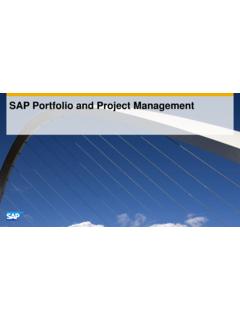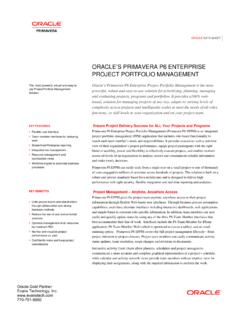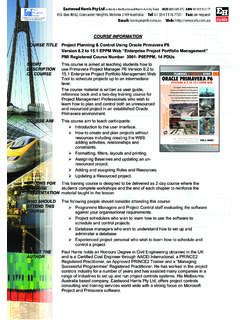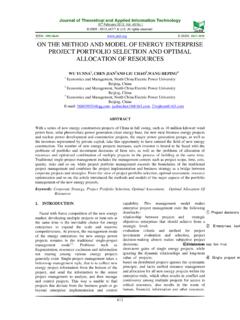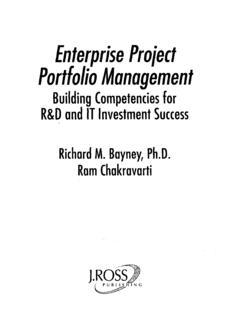Transcription of Implementing Project Portfolio Management
1 Keys to Implementing Project Portfolio Management Lee Merkhofer, Project Portfolio Management (PPM) is a tool-supported process for optimally selecting and managing the organization s Portfolio of projects. PPM can provide real value, but many organizations are finding Implementing PPM difficult. This paper describes seven keys to success and presents a recommended step-by-step process for PPM implementation. c 2007-2009 Lee Merkhofer Consulting Implementing Project Portfolio Management i c 2007-2009 Lee Merkhofer Consulting Table of Contents Introduction.
2 2 1. Embrace PPM Principles ..3 2. Choose an Approach that Fits ..3 3. Secure Executive Support ..4 4. Establish Governance Structure ..5 5. Develop a Value-Measurement Framework ..7 6. Implement Effective Processes ..8 7. Institute Essential Capabilities ..9 8. Follow a Roadmap for PPM Implementation ..11 Step 1: Assess Current Capabilities .. 11 Step 2: Analyze Stakeholders .. 11 Step 3: Define PPM Implementation Teams .. 11 Step 4: Develop a Charter .. 12 Step 5: Design Your PPM Approach and Value Measurement Framework .. 12 Step 6: Pilot Test the Approach .. 12 Step 7: Build or Acquire a PPM Tool.
3 13 Step 8: Roll It Out .. 13 Step 9: Practice Continuous Learning .. 14 Critical Success Factors ..14 Summary ..14 Notes .. 14 Implementing Project Portfolio Management Introduction So, your organization is ready to implement Project Portfolio Management (PPM). Congratulations! PPM is an effective business practice that can enable you to generate significantly more value from your Project investments, even while cutting costs. Best practice organizations are finding that PPM enables them to make better, more informed, and more cost-effective decisions on an on-going and regular basis. Be aware, though, that the road to PPM is often rocky.
4 For many organizations, successfully Implementing PPM is difficult and time-consuming. Also, establishing PPM is a high-risk initiative. Failures are not uncommon. There is no way to guarantee that you will be successful in Implementing PPM. However, having observed many organizations at various stages of the process, I have concluded that there are 8 keys to success: (1) embrace the principles involved, (2) choose an approach that fits, (3) secure executive support, (4) establish governance, (5) create a value-measurement framework, (6) implement effective processes, (7) institutionalize essential capabilities, and (8) follow a road map.
5 Figure 1: Keys to Implementing PPM 2 c 2007-2009 Lee Merkhofer Consulting Implementing Project Portfolio Management 3 c 2007-2009 Lee Merkhofer Consulting 1. Embrace PPM Principles PPM is not just another Project Management process. PPM is a philosophy one that, in accordance with the analogy based on financial Portfolio Management , is focused on value creation. Getting the most from PPM requires reshaping thinking. Your people should fully embrace the following principles1: Projects will be managed as a Portfolio of investments. The goal is to create the greatest possible value (considering the resources available and accounting for risk and organizational risk tolerance).
6 For the purpose of decision making, projects will be defined to include the full scope of activities necessary to generate value. Because projects produce different types of value in different ways, they must be evaluated and managed differently. Value delivery will be managed throughout the Project life-cycle and the life-cycle of any products, services, or assets created or enhanced by the Project . Value delivery practices will engage all stakeholders and assign appropriate accountability for the delivery of Project benefits and the realization of value. Value delivery practices will be continually monitored, evaluated, and improved.
7 Getting clarity on basic principles is important for three reasons. First, decisions at all levels of the organization affect value creation. If only Project -acceptance decisions are made consistent with value maximization, the gain can easily be undone if countless, day-to-day, apparently simple choices aren t in tune. The principles must be applied universally. Second, getting clarity on the principles promotes understanding and agreement on what you are doing and why. They provide a compelling argument for overcoming inertia and the status quo. Third, the principles provide the foundation for creating the structure, supporting processes, and tools that will enable you to put the principles into practice.
8 They translate readily into design specifications for your PPM implementation. 2. Choose an Approach that Fits PPM is not a one-size-fits-all solution. Despite the general applicability of the principles, there is no single, universal approach to PPM. The alternative approaches reflect different views on how best to accomplish PPM goals, and the appropriateness of those alternative views depends on the specific situation and practical realities. Different approaches reflect different assumptions, methodologies, models, structures, roles and responsibilities, reporting lines, resource demands, and levels of authority.
9 The challenge is choosing and designing an approach that will work for your organization. 1 These principles are essentially the same as those established for IT Portfolio Management by the Information Systems Audit and Control Association (ISACA), as described in the suite of documents known as Val IT (see, for example, pg 13, Enterprise Value: Governance of IT Investments, The Val IT Framework, IT Governance Institute, 2006) . ISACA is an international body concerned with IT governance and auditing. Implementing Project Portfolio Management Why do different organizations need different approaches?
10 Organizations in different industries conduct different kinds of projects that create value in different ways. Also, an organization that conducts hundreds of projects each year has different needs than one that conducts a half dozen. A decentralized organization requires a different structure for decision support than one where decisions are centralized. A key function of PPM is to measure and account for risk, but the nature and magnitude of the relevant risks differs greatly, as does the willingness and ability of organizations to accept risk. Furthermore, your PPM solution should minimize necessary changes to those aspects of your current systems that are working well.
